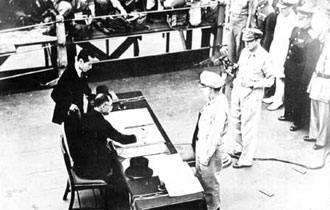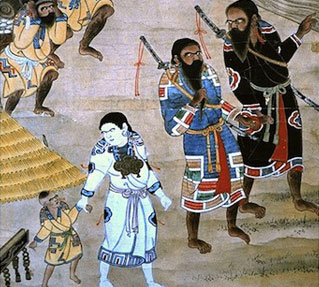Pages |
Meiji Period to Showa Period
The sudden shift in the Meiji Period (1868-1912) led to major societal changes all across Japan. Fuke temples were shut down, begging for alms was banned, and the shakuhachi officially left the domain of priests and could be played by anyone, with or without a license. One of reasons for this shift in government attitudes towards the monks was a desire to remove all traces of feudal hierarchical structures in Japan in an effort to mimic the Western Powers that the Meiji government admired and wished to emulate. Those monks who adhered strictly to performing the Fuke honkyoku repertory of the shakuhachi and refused to embrace playing gaikyoku became increasing rare, while the demand for players who embraced gaikyoku repertoire increased. However, by 1881 thanks to the efforts of Kinko school players like Yoshida Itchō 吉田一調 (1812-1881) and Araki Kodō II 二世荒木古童 (1823-1908), the government was convinced to allow shakuhachi players to practice and perform in any style. In the late nineteenth century, the temple Myōan-ji明暗寺was established in Kyoto for players who wished to pursue the shakuhachi as an instrument for spiritual enlightenment. In 1892 Higuchi Taizan 樋口対山 (1856-1914) would establish the Myōan Kyōkai 明暗協会 (Myōan Association). This style of shakuhachi playing was rooted in meditation and suizen 吹禅 (lit. “blowing zen”). Much later, practitioners of this style would call this lineage Myōan Taizan-ha 明暗大山派.
It is also around this time that the first standardized notation systems for shakuhachi music were produced by Araki Kodō. While Kinko school repertoire and study places a great deal of emphasis on the thirty-six standard solo pieces, the majority of the music students study and learn first are gaikyoku compositions, particularly the sankyoku compositions that accompany shamisen and koto. Typically, students begin learning the honkyoku only after learning all gaikyoku pieces. The Kinko style of playing became extremely popular in the Tokyo region during the late nineteenth century and early twentieth century.
Concurrently, in Osaka another shakuhachi style became increasingly popular at the beginning of the twentieth century. Born into a musical family, Tozan Nakao 都山中尾 (1876-1956) learned jiuta (music originally composed for shamisen) music from his shamisen playing mother and learned shakuhachi on his own. By the age of twenty-one, Tozan had established his own school in Osaka and was making additions to established jiuta musical compositions. He developed a new notation system, different from the ones proposed by the Myōan Taizan-ha and Kinko styles of playing, and by 1904 was composing his own compositions informed by trends in Western music that were changing the Japanese musical landscape as a whole (Koto and Tanaka 2016.)
Pages |











